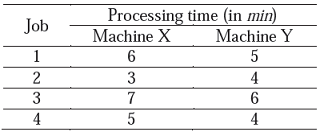GATE 2017-2018 :: GATE Production
- In a CAD package, mirror image of a 2D point P(5,10) is to be obtained about a line which passes through the origin and makes an angle of 45° counterclockwise with the X-axis. The coordinates of the transformed point will be
- In water jet machining, the water jet is issued through a 0.3 mm diameter orifice at a pressure of 400 MPa. The density of water is 1000 kg/m3. The coefficient of discharge is 1.0. Neglecting all losses during water jet formation through the orifice, the power of the water jet in kW is
-
A linear programming problem is shown below.Maximize 3x + 7ySubject to 3x + 7y ≤ 104x + 6y ≤ 8x, y ≥ 0It has
-
Consider a two machine flow shop where jobs are first processed in Machine X and then in Machine Y, in the same sequence. The processing times of four jobs (1, 2, 3 and 4) on the machines are:
 The sequence of jobs on the machines that minimizes make span is
The sequence of jobs on the machines that minimizes make span is -
Match the CORRECT pairs.

-
A firm produces 120 units of product in every 8 hour shift. Four operations as given below are needed to manufacture each unit of product.
 The above operations are to be assigned to workstations, such that one or more operations are performed in each workstation. Only one unit of product will be processed in each workstation at a time. The minimum number of workstations that will achieve the production target, without violating the precedence constraints, is
The above operations are to be assigned to workstations, such that one or more operations are performed in each workstation. Only one unit of product will be processed in each workstation at a time. The minimum number of workstations that will achieve the production target, without violating the precedence constraints, is -
A disc of 200 mm outer and 80 mm inner diameter is faced at a feed of 0.1 mm/rev with a depth of cut of 1 mm. The facing operation is undertaken at a constant cutting speed of 90 m/min in a CNC lathe. The main (tangential) cutting force is 200 N. Neglecting the contribution of the feed force towards cutting power, the specific cutting energy in J/mm3 is
-
A disc of 200 mm outer and 80 mm inner diameter is faced at a feed of 0.1 mm/rev with a depth of cut of 1 mm. The facing operation is undertaken at a constant cutting speed of 90 m/min in a CNC lathe. The main (tangential) cutting force is 200 N. Assuming approach and over-travel of the cutting tool to be zero, the machining time in min is
-
The demand for soap at a retailer is 40 kg per day. The retailer buys soap from a company in bulk at the cost of Rs. 50 per kg. The retailer incurs a cost of Rs. 200 to place an order to the company, and a holding cost of Rs. 0.1 per kg per day to store the soap. The lead time between the placing and receiving of orders is 3 days. The retailer's current ordering policy is to order 200 kg every 5 days. To avoid stock out situations, the retailer needs to place orders when the inventory level (in kg) drops to
-
The demand for soap at a retailer is 40 kg per day. The retailer buys soap from a company in bulk at the cost of Rs. 50 per kg. The retailer incurs a cost of Rs. 200 to place an order to the company, and a holding cost of Rs. 0.1 per kg per day to store the soap. The lead time between the placing and receiving of orders is 3 days. The retailer's current ordering policy is to order 200 kg every 5 days. If the retailer uses an optimum order policy to minimize the total cost, the saving in Rs. in the total cost as compared to the current policy will be


 Whatsapp
Whatsapp
 Facebook
Facebook

